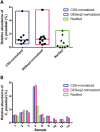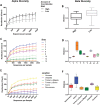Detection of Coccidioides posadasii from xerophytic environments in Venezuela reveals risk of naturally acquired coccidioidomycosis infections
- PMID: 29593263
- PMCID: PMC5874253
- DOI: 10.1038/s41426-018-0049-6
Detection of Coccidioides posadasii from xerophytic environments in Venezuela reveals risk of naturally acquired coccidioidomycosis infections
Abstract
A wide range of mammals are susceptible to infection by the fungal species Coccidioides immitis and C. posadasii. In humans, 60% of infections are asymptomatic; however, certain patients may develop a severe and deep systemic mycosis called coccidioidomycosis. Genetic analysis suggests that the majority of clinical isolates recovered from South America are C. posadasii; however, little is known about the prevalence, species distribution, and ecological factors that favor the occurrence of this pathogen in those areas. By using a combined quantitative polymerase chain reaction (qPCR)-based approach and mycobiome amplicon sequencing, we provide evidence that at least two genotypes of C. posadasii are found in the xerophytic environment in Venezuela. We detected a 3806-fold range in the amount of Coccidioides DNA when comparing among the sampled locations, which indicates that human exposure risk is variable, and is one critical factor for disease manifestation. We identified fungal communities that are correlated with a higher prevalence of C. posadasii, suggesting that a combination of specific microbes and a xeric microenvironment may favor the growth of Coccidioides in certain locations. Moreover, we discuss the use of a combinatorial approach, using both qPCR and deep-sequencing methods to assess and monitor fungal pathogen burden at outbreak sources.
Conflict of interest statement
The authors declare that they have no conflict of interest.
Figures



Similar articles
-
Population Structure and Genetic Diversity among Isolates of Coccidioides posadasii in Venezuela and Surrounding Regions.mBio. 2019 Nov 26;10(6):e01976-19. doi: 10.1128/mBio.01976-19. mBio. 2019. PMID: 31772050 Free PMC article.
-
Factors Influencing Distribution of Coccidioides immitis in Soil, Washington State, 2016.mSphere. 2021 Dec 22;6(6):e0059821. doi: 10.1128/mSphere.00598-21. Epub 2021 Nov 3. mSphere. 2021. PMID: 34730378 Free PMC article.
-
Real-time PCR assay for detection and differentiation of Coccidioides immitis and Coccidioides posadasii from culture and clinical specimens.PLoS Negl Trop Dis. 2021 Sep 16;15(9):e0009765. doi: 10.1371/journal.pntd.0009765. eCollection 2021 Sep. PLoS Negl Trop Dis. 2021. PMID: 34529679 Free PMC article.
-
The mysterious desert dwellers: Coccidioides immitis and Coccidioides posadasii, causative fungal agents of coccidioidomycosis.Virulence. 2019 Dec;10(1):222-233. doi: 10.1080/21505594.2019.1589363. Virulence. 2019. PMID: 30898028 Free PMC article. Review.
-
Coccidioidomycosis in Latin America.Med Mycol. 2019 Feb 1;57(Supplement_1):S46-S55. doi: 10.1093/mmy/myy037. Med Mycol. 2019. PMID: 30690597 Review.
Cited by
-
Characterizing the soil microbial community associated with the fungal pathogen Coccidioides immitis.bioRxiv [Preprint]. 2024 Sep 28:2024.09.27.615053. doi: 10.1101/2024.09.27.615053. bioRxiv. 2024. Update in: J Fungi (Basel). 2025 Apr 14;11(4):309. doi: 10.3390/jof11040309. PMID: 39386668 Free PMC article. Updated. Preprint.
-
Coccidioides undetected in soils from agricultural land and uncorrelated with time or the greater soil fungal community on undeveloped land.PLoS Pathog. 2023 May 25;19(5):e1011391. doi: 10.1371/journal.ppat.1011391. eCollection 2023 May. PLoS Pathog. 2023. PMID: 37228157 Free PMC article.
-
Characterizing the Soil Microbial Community Associated with the Fungal Pathogen Coccidioides immitis.J Fungi (Basel). 2025 Apr 14;11(4):309. doi: 10.3390/jof11040309. J Fungi (Basel). 2025. PMID: 40278129 Free PMC article.
-
From soil to clinic: current advances in understanding Coccidioides and coccidioidomycosis.Microbiol Mol Biol Rev. 2024 Dec 18;88(4):e0016123. doi: 10.1128/mmbr.00161-23. Epub 2024 Oct 4. Microbiol Mol Biol Rev. 2024. PMID: 39365073 Review.
-
Population Structure and Genetic Diversity among Isolates of Coccidioides posadasii in Venezuela and Surrounding Regions.mBio. 2019 Nov 26;10(6):e01976-19. doi: 10.1128/mBio.01976-19. mBio. 2019. PMID: 31772050 Free PMC article.
References
MeSH terms
LinkOut - more resources
Full Text Sources
Other Literature Sources
Medical
